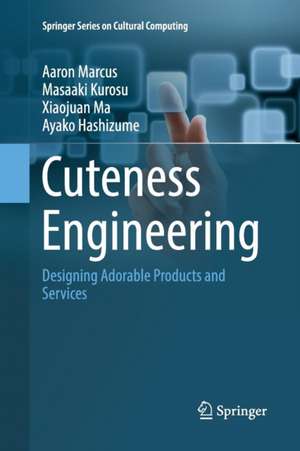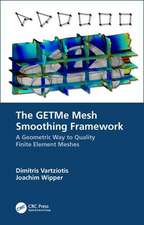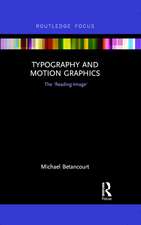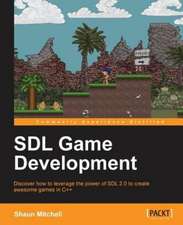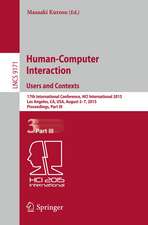Cuteness Engineering: Designing Adorable Products and Services: Springer Series on Cultural Computing
Autor Aaron Marcus, Masaaki Kurosu, Xiaojuan Ma, Ayako Hashizumeen Limba Engleză Paperback – 24 mai 2018
The authors provide detailed analyses and histories of cuteness in Japan and in China, the rise of Kawaii and Moe cultural artifacts, and their relation to social, psychological, and design issues. They also attempt an initial taxonomy of cuteness. Finally, detailed interviews with leading designers of cute products and services, such as Hello Kitty, provide an understanding of the philosophy and decision-making process of designers of cuteness.
Cuteness Engineering: Designing Adorable Products and Services will be of interest and use to a wide range of professionals, researchers, academics, and students who are interested in exploring the world of cuteness in fresh new ways and gaining insights useful for their work and studies.
| Toate formatele și edițiile | Preț | Express |
|---|---|---|
| Paperback (1) | 639.72 lei 43-57 zile | |
| Springer International Publishing – 24 mai 2018 | 639.72 lei 43-57 zile | |
| Hardback (1) | 645.97 lei 43-57 zile | |
| Springer International Publishing – 10 noi 2017 | 645.97 lei 43-57 zile |
Din seria Springer Series on Cultural Computing
- 20%
 Preț: 648.26 lei
Preț: 648.26 lei - 20%
 Preț: 657.02 lei
Preț: 657.02 lei - 20%
 Preț: 167.45 lei
Preț: 167.45 lei - 20%
 Preț: 259.94 lei
Preț: 259.94 lei - 20%
 Preț: 332.89 lei
Preț: 332.89 lei - 20%
 Preț: 989.96 lei
Preț: 989.96 lei - 20%
 Preț: 660.48 lei
Preț: 660.48 lei - 20%
 Preț: 1308.39 lei
Preț: 1308.39 lei - 20%
 Preț: 936.37 lei
Preț: 936.37 lei - 20%
 Preț: 1164.84 lei
Preț: 1164.84 lei - 20%
 Preț: 334.20 lei
Preț: 334.20 lei - 20%
 Preț: 1165.69 lei
Preț: 1165.69 lei - 20%
 Preț: 937.44 lei
Preț: 937.44 lei - 20%
 Preț: 1046.24 lei
Preț: 1046.24 lei - 20%
 Preț: 1056.78 lei
Preț: 1056.78 lei - 20%
 Preț: 322.50 lei
Preț: 322.50 lei - 20%
 Preț: 934.84 lei
Preț: 934.84 lei - 20%
 Preț: 341.95 lei
Preț: 341.95 lei - 20%
 Preț: 1051.32 lei
Preț: 1051.32 lei - 20%
 Preț: 900.51 lei
Preț: 900.51 lei - 20%
 Preț: 1284.98 lei
Preț: 1284.98 lei - 20%
 Preț: 660.53 lei
Preț: 660.53 lei - 20%
 Preț: 897.81 lei
Preț: 897.81 lei - 20%
 Preț: 367.28 lei
Preț: 367.28 lei - 20%
 Preț: 1159.10 lei
Preț: 1159.10 lei - 20%
 Preț: 645.97 lei
Preț: 645.97 lei - 20%
 Preț: 338.16 lei
Preț: 338.16 lei - 20%
 Preț: 655.02 lei
Preț: 655.02 lei - 20%
 Preț: 648.95 lei
Preț: 648.95 lei - 20%
 Preț: 710.52 lei
Preț: 710.52 lei - 20%
 Preț: 1050.86 lei
Preț: 1050.86 lei - 20%
 Preț: 1164.05 lei
Preț: 1164.05 lei - 20%
 Preț: 1052.79 lei
Preț: 1052.79 lei - 20%
 Preț: 652.07 lei
Preț: 652.07 lei
Preț: 639.72 lei
Preț vechi: 799.65 lei
-20% Nou
Puncte Express: 960
Preț estimativ în valută:
122.43€ • 127.34$ • 101.07£
122.43€ • 127.34$ • 101.07£
Carte tipărită la comandă
Livrare economică 14-28 aprilie
Preluare comenzi: 021 569.72.76
Specificații
ISBN-13: 9783319872001
ISBN-10: 3319872001
Ilustrații: XVI, 161 p. 121 illus., 73 illus. in color.
Dimensiuni: 155 x 235 mm
Greutate: 0.26 kg
Ediția:Softcover reprint of the original 1st ed. 2017
Editura: Springer International Publishing
Colecția Springer
Seria Springer Series on Cultural Computing
Locul publicării:Cham, Switzerland
ISBN-10: 3319872001
Ilustrații: XVI, 161 p. 121 illus., 73 illus. in color.
Dimensiuni: 155 x 235 mm
Greutate: 0.26 kg
Ediția:Softcover reprint of the original 1st ed. 2017
Editura: Springer International Publishing
Colecția Springer
Seria Springer Series on Cultural Computing
Locul publicării:Cham, Switzerland
Cuprins
Foreword.- Preface.- Introduction.- Cuteness in Japan.- Cuteness in China.- Taxonomy of Cuteness.- Cuteness Designer Interview: Yuuko Yamaguchi, Design Manager, Hello Kitty.- Cuteness Designer Interview: Wentao Huang, Senior UX Designer, Baidu, China.- Conclusions and Closing Thoughts.
Recenzii
“The book provides a new theoretical model to understand the cultural and contextual meanings of personality design, specifically cuteness. This model has the potential to lead user-experience professionals and software developers toward the future of personality design in artificial intelligence.” (Laura Rokey, IEEE Transactions on Professional Communication, Vol. 62 (1), March, 2019)
Notă biografică
Aaron Marcus, Principal of Aaron Marcus and Associates (AM+A), and Editor-in-Chief Emeritus of User Experience Magazine, is a pioneer of user-experience design, publisher of 29 books and more than 300 articles, and the first graphic designer to be elected to both the CHI Academy and to the AIGA Fellows. AM+A has been in business for more than a 35 years, providing user-centered solutions on projects ranging from start-up ventures to business applications launched by some of the largest companies in the world. AM+A has served approximately 300 clients and completed approximately 500 projects.
Masaaki Kurosu is a Professor Emeritus at the Open University of Japan, since 2017 and is an Emeritus President of HCD-Net after working as a President for 10 years. He was a professor at the Open University of Japan for 2009-2017 and was a professor at NIME for 2001-2009, a professor at Shizuoka University for 1996-2001. He was formerly working for Hitachi Ltd. at the Design Center and the Central Research Laboratory for 1978-1996. He proposed the concept of User Engineering, AET (Artifact Evolution Theory), ERM (Experience Recollection Method) and other usability/UX-related methods and concepts.
Xiaojuan Ma is an assistant professor of the Human-Computer Interaction Initiative in the Department of Computer Science and Engineering at the Hong Kong University of Science and Technology. She received her Ph.D. degree in Computer Science at Princeton University. Before joining HKUST, she was a post-doc at the Human-Computer Interaction Institute of Carnegie Mellon University, a research fellow in the National University of Singapore, and a researcher at Huawei Noah's Ark Lab. Her background is in Human-Computer Interaction. She is particularly interested in multimodal affective computing in the domain of ubiquitous, social, and crowd computing and Human-Robot Interaction.
Ayako Hashizume is an assistant professor at the Tokyo Metropolitan University since 2012. Her research interests include psychology of emotion and Kansei, engineering in relation to Human Centered Design and UX (user experience). She was awarded the kids design prospective competition 2008 from the Japan Kids Design Association, the best design prize at the design marathon 2009 from the International Association for Universal Design and the research prize 2013 from the Funai Foundation for Information Technology. She is a chief of the SIG-Kansei of HCD-Net. She received her Ph.D. in Kansei Science from Tsukuba University, Japan, in 2011.
Xiaojuan Ma is an assistant professor of the Human-Computer Interaction Initiative in the Department of Computer Science and Engineering at the Hong Kong University of Science and Technology. She received her Ph.D. degree in Computer Science at Princeton University. Before joining HKUST, she was a post-doc at the Human-Computer Interaction Institute of Carnegie Mellon University, a research fellow in the National University of Singapore, and a researcher at Huawei Noah's Ark Lab. Her background is in Human-Computer Interaction. She is particularly interested in multimodal affective computing in the domain of ubiquitous, social, and crowd computing and Human-Robot Interaction.
Ayako Hashizume is an assistant professor at the Tokyo Metropolitan University since 2012. Her research interests include psychology of emotion and Kansei, engineering in relation to Human Centered Design and UX (user experience). She was awarded the kids design prospective competition 2008 from the Japan Kids Design Association, the best design prize at the design marathon 2009 from the International Association for Universal Design and the research prize 2013 from the Funai Foundation for Information Technology. She is a chief of the SIG-Kansei of HCD-Net. She received her Ph.D. in Kansei Science from Tsukuba University, Japan, in 2011.
Textul de pe ultima copertă
This state of the art monograph presents a unique introduction to thinking about cuteness and its incorporation into modern, especially computer-based, products and services. Cuteness is defined and explored in relation to user-centered design concepts and methods, in addition to considering the history of cuteness and cuteness in other cultures, especially in relation to eastern Asia.
The authors provide detailed analyses and histories of cuteness in Japan and in China, the rise of Kawaii and Moe cultural artifacts, and their relation to social, psychological, and design issues. They also attempt an initial taxonomy of cuteness. Finally, detailed interviews with leading designers of cute products and services, such as Hello Kitty, provide an understanding of the philosophy and decision-making process of designers of cuteness.
Cuteness Engineering: Designing Adorable Products and Services will be of interest and use to a wide range of professionals, researchers, academics, and students who are interested in exploring the world of cuteness in fresh new ways and gaining insights useful for their work and studies.
The authors provide detailed analyses and histories of cuteness in Japan and in China, the rise of Kawaii and Moe cultural artifacts, and their relation to social, psychological, and design issues. They also attempt an initial taxonomy of cuteness. Finally, detailed interviews with leading designers of cute products and services, such as Hello Kitty, provide an understanding of the philosophy and decision-making process of designers of cuteness.
Cuteness Engineering: Designing Adorable Products and Services will be of interest and use to a wide range of professionals, researchers, academics, and students who are interested in exploring the world of cuteness in fresh new ways and gaining insights useful for their work and studies.
Caracteristici
Presents an innovative, overview analyses of the history and significance of cuteness in Japanese and Chinese cultures Relates cuteness design to user-centered design philosophy, which increases the usefulness of the analyses in the book Includes interviews with leading designers of cute products and services Provides a useful taxonomy of cuteness, which can assist designers, evaluators, researchers and other professionals Includes supplementary material: sn.pub/extras
